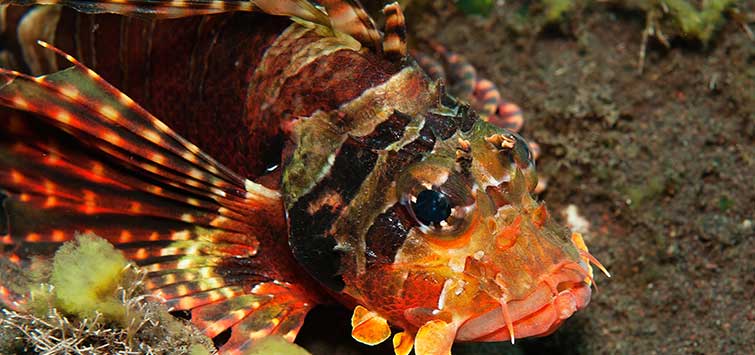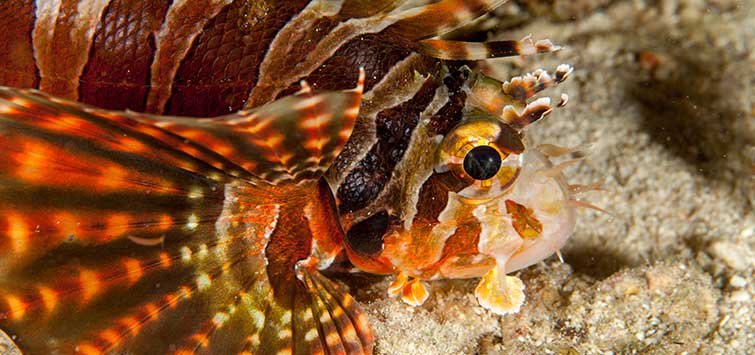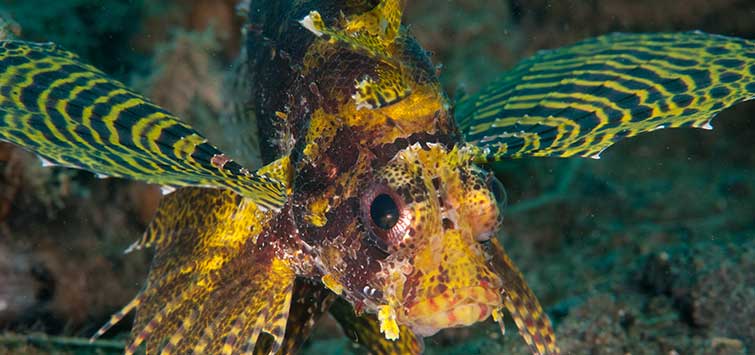The Dwarf Lions
Author: Bob Fenner
Being smaller than their red lion cousins, dwarf lions make more manageable additions to the average tank. Beautiful, hardy, and graceful, they are sure to pop in any setup.
Smaller Is Better
Dwarf lionfishes are definitely a case where good things come in small(er) packages. One advantage is that they are not as likely to swallow small fish and non-fish tankmates, but beware—their gulp is larger than it may seem and many fishes and invertebrates are inhaled daily by these diminutive scorpionfishes.
Another caveat: Size bears little relation to the power of their sting. Like small rattlesnakes, small lionfish are just as venomous as their larger brethren, so watch where you put your hands when working in their tanks!
Dwarf Lionfishes on Parade
The dwarf lions are generally considered to include four of the five members of the genus Dendrochirus, though at least one of the smaller Pterois spp. is labeled as such because of its smaller size and more sedentary, bottom-dwelling habits.
Hawaiian Lionfish (Dendrochirus barberi)
The Hawaiian lionfish (D. barberi), also known by divers as the green lionfish, is found in the eastern central Pacific in Hawaii and the Johnston Atoll. It is found anywhere from 3 to 165 feet down, generally resting on coral or in rocky recesses, and reaches about 6 inches in length. As I mentioned earlier, be aware of the powerful venom it releases when touched.
D. bellus
D. bellus comes from the northwestern Pacific, Japan and Taiwan, and is never seen in the trade. It reaches 6 inches in length.
Two-Spot Lion (D. biocellatus)
D. biocellatus goes by many common names, such as two-spot lionfish, twin-spot lion, and Roo or Fu Manchu lion. But no matter what it is called, it is unmistakable, with its two eye spots on the rear dorsal fin area and two whisker-like appendages extending from the lower jaw. Able to reach almost 5 inches in length, this is a widespread species found throughout the tropical Indian Ocean to the western Pacific.
Fuzzy Lionfish (D. brachypterus)
The shortfin dwarf or fuzzy lion (D. brachypterus) is a rarer, more heavy-bodied dwarf. It often shows up with a good deal of yellow, brown, and green mixed with red markings. This dwarf is aptly named because it has very large pectoral fins with almost no emerging ray tips. The fish is found in the Indo-West Pacific, from East Africa to the Red Sea to southern Japan, Australia, and Micronesia. It is one of the most personable marine species, quickly recognizing and responding to its owner’s presence.
Zebra Turkeyfish (D. zebra)
The zebra turkeyfish (D. zebra), the most common dwarf lion, is similar in many ways to Pterois antennata and P. sphex. The one sure way of identifying this species is by checking for its distinguishing mark: two white spheres on its caudal peduncle. It is found in the Indo-West Pacific—the Red Sea, East Africa, to Southern Japan, Australia—and reaches 10 inches in length.
A Smallish Pterois Lionfish
There are also a few “true” lions that could be considered dwarves, and I definitely consider P. sphex to be one. It is a Hawaiian endemic that is often mistakenly sold as an antennata lion, which it closely resembles in terms of pectoral finnage. The fins of P. sphex are shorter, less colorful, and more clubbed in appearance. Though more costly than the majority of lions, which are imported from the Philippines and Indonesia, Hawaiian lions are my favorite for hardiness. This one reaches 8 inches in length.
Selection
For the most part, lionfishes are easily captured (they don’t swim quickly and are easily found in the wild), but they do take a beating on their way to dealers. For large fishes with sizable appetites, they are rather sensitive to ammonia poisoning and low oxygen concentration. I recommend that you follow these guidelines when purchasing a lionfish:
1. Don’t buy newly arrived specimens—let the poor fish rest up from being collected for a few days to a week, as they are all wild captured. Most all anomalous losses of these fishes occur within a few days of collection and transport.
2. Don’t purchase individuals that appear spaced out. Healthy specimens are bright eyed, alert, aware of your presence, and not cowering in the corner. They also don’t have cloudy eyes.
3. Avoid specimens with red markings or open sores. Torn fins (they get broken in collection) are fine and will mend, but look out for bad scrapes and infected lateral lines. Look particularly at the fin insertion areas of the body for tears and evidence of bleeding. Most damaged individuals will heal, but it’s best that they not be moved about when they are so impugned.
4. Hold off purchasing fishes that don’t eat at your local fish store. This old piece of advice is a valid yes/no decision maker for purchasing lions. A healthy lionfish will always show interest or, at least, awareness of potential food items in its vicinity. If one you have your eye on won’t take food in front of you, put it on layaway with a deposit and come back for it at a later date when you can see it feeding.
Systems
Despite the prevalent belief that lions don’t need to be put into large tanks with extensive filtration, aeration, and circulation because they just sit around, they do need all of those things. Although they are quite sedentary, dwarf lionfishes are messy in terms of the foods they consume and the wastes they produce. Their size and weight are also considerable in light of their small build. My friend and Wet Web Media member James Gasta has a good rule of thumb for marine stocking—one cubic inch of life per 5 gallons of water. Given this measure instead of the oft-repeated length per so many gallons, you can see that bulky lionfish species need room. I would not put one of these fishes in less than a 40-gallon system.
Filtration
Filtration, likewise, needs to be high quality, allowing for both the steady secretion of ammonia from the fish’s gills and the periodic expulsion of solid and liquid wastes. Similarly, their water needs to be maintained in a highly oxygenated state, with vigorous circulation.
pH Considerations
Though it’s not talked about often, lionfish can and do modify the water they’re in at times, sometimes to disastrous degrees. Alkalinity and pH, in particular, often slide with systems housing lionfish. Even given a decent volume of water, plenty of calcareous substrate, and calcareous rocks in their tank, your aquarium can have a precipitous slide in buffering capacity without regular partial water changes. Do keep an eye on your pH and dKH.
Lighting
Lastly, I want to include a stock mention of lighting and scorpaenid (mail-cheeked) fishes. They are susceptible to a blinding syndrome as a consequence of being placed in overly bright settings that lack caves and overhangs. If you detect cloudiness in your lion’s eyes, I’d first check (and rectify) the pH, but then look to providing shade or moving this fish from an overlit tank. Provide sufficient cover, caves, and overhangs for your dwarf lions to hang out (upside down or right-side up). This is what they do in the wild during the day.
Tankmates
There are two basic rules to matching livestock with dwarf lions—make sure to avoid anything small enough to fit in their capacious mouths and, secondly, don’t include anything that will harass them. The first category includes motile invertebrates—small crabs and shrimps—as they can all be inhaled. Larger basses, eels, triggers, puffers, big angels, and some other miscellaneous fishes may pick on your small lion to its demise.
Unlike the case with some of the Pterois species, dwarf lions rarely (but can) show intraspecific aggression and are, in fact, often encountered in loosely associated groups in the wild. More than one species may be housed in the same system, given adequate space, food, etc.
Feeding
Small lionfish species enjoy chunky, meaty foods. That means live food in the wild, but they can almost always be trained to accept cut meat or freeze-dried and frozen items in captivity. Be aware that this may take some work on your part and include periods of starvation on their part. These fishes can, indeed, go without food for a few to several weeks. Don’t give in to the foolhardy practice of feeding them freshwater feeders—comet goldfish, livebearers, rosies—because they are poor in nutrition, expensive, inconvenient, and the hands-down number-one killer of these fishes from either fatty degeneration internally over time or outright gut blockage.
If your lion is getting too thin and looking starved, a live glass or ghost shrimp will likely be readily accepted. Otherwise, devise a feeding stick (wood or plastic) that you can attach nonlive food items to and practice waving these meaty food offerings (silversides, lancefish, shrimp—whole or in pieces) in front of your lion’s face toward the evening (most are crepuscular to nocturnal ambush predators). You will have a fine aqua pet in time.
Feeding them twice a week is about right, but never feed to satiation, as you don’t want to make the lion look or feel like a living balloon.
Diseases
Though far more lionfishes, both small and large species, are killed from misfeeding (largely feeder goldfish) and self-caused pollution from being in aquariums too small, they are susceptible to the usual reef fish maladies, particularly Cryptocaryon and Amyloodinium.
Being sensitive to variable water quality also includes an aversion to typical medications, so any containing copper compounds, formalin, and dyes like malachite green should be administered in the lowest possible physiological dose. And even then, the animals should be watched closely for signs of overtreatmentand new water should be kept ready for changes if needed. Protozoan and dinoflagellate diseases can often be eradicated with a simple pH-adjusted freshwater and half-dose formalin dip/bath enroute to a treatment/quarantine tank, allowing the main/display tank to go fallow for a month while the parasites die off or lose pathogenicity.
A note to dealers: An extended bath or full treatment (250 mg/10 gallons) of nitrofurazone can often result in miraculous reincarnation of badly beat-up, fin-tattered specimens that arrive to you in very poor condition.
Reproduction
Lionfishes, including dwarf species, have spawned in captivity, particularly D. brachypterus. They do so in the wild in a haremic condition, with one male and a few females. In breeding condition, females swell with eggs. Spawning occurs by dark of night; the sticky egg-mass floats toward the surface, and a day and a half later, the gelatinous mass dissolves and the developing fry take food.
Keep a Dwarf Lion
Dwarf lionfish species really differ from their larger, related kin only by size and a propensity to sit at the bottom more. The smaller lionfish species require the same good-sized, well-filtered, and aerated systems as the bigger ones. They can be similarly trained to eat nonlive foods and are harmed by the same inappropriate live freshwater ones.
As with the larger “true” lionfishes, one must be cautious when having their hands in these fishes’ tanks. Whether they’re alive or not, all lionfish species are painfully venomous. Keep your eye on these fishes when working in their tanks.
See the full article on TFH Digital http://www.tfhdigital.com/tfh/201204#pg89

.png?h=595&iar=0&w=2781&hash=5FD5E69473BCC22199FBFA2FB71B6033)



